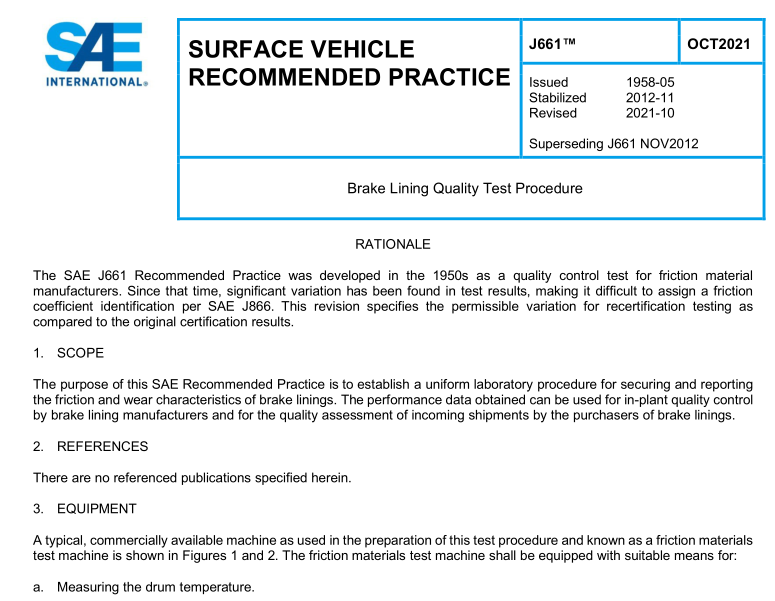SAE J661:2021 pdf download Brake Lining Quality Test Procedure
1. SCOPE
The purpose of this SAE Recommended Practice is to establish a uniform laboratory procedure for securing and reporting the friction and wear characteristics of brake linings. The performance data obtained can be used for in-plant quality control by brake lining manufacturers and for the quality assessment of incoming shipments by the purchasers of brake linings.
2. REFERENCES
There are no referenced publications specified herein.
3. EQUIPMENT
A typical, commercially available machine as used in the preparation of this test procedure and known as a friction materials test machine is shown in Figures 1 and 2. The friction materials test machine shall be equipped with suitable means for:
a. Measuring the drum temperature.
b. Heating the drum.
c. Controlling the drum heating rate.
d. Cooling the drum from the back side only.
e. Controlling the drum cooling rate.
f. Measuring friction force.
g. Measuring drum rotational speed.
Means shall be provided for measuring specimen thickness and mass.
4. TEST CONDITIONS
Actual tests for performance shall be started when preparations have been completed in accordance with Section 5.
4.1 Conduct of Test
All testing shall proceed without interruption.
4.2 Drum Speeds
All drum speeds (rpm) are based on a nominal 279.4 mm (11.0 inch) diameter drum with load applied to the specimen.
5. PROCEDURE
5.1 Preparation of Test Specimen
The test specimen shall be taken from the center of the friction material approximately equidistant from each end.
The test specimen shall have dimensions of 25.4 x 25.4 mm (1.0 x 1.0 inch), flat on the bottom, and the radius of the working surface shall conform to the radius of the test drum. On pre-ground linings, remove at least 0.3 mm (0.01 inch), but not more than 0.5 mm (0.02 inch) from the working surface of the specimen. For unground linings (directly from molds), remove 1.0/1.2 mm (0.04/0.05 inch) to be certain that the resin impregnated surface is totally removed. Specimen thickness (or specimen plus shim) should be approximately 6 mm (0.24 inch) measured in the center of specimen. Excess of material must be removed from the side opposite the working surface of the specimen. In cases where nominal lining thickness is less than 5 mm (0.20 inch), remove a minimum amount of material from the side opposite the working surface to produce flatness.
The working surface of the specimen shall not be handled and shall be kept free from foreign material.
5.2 Preparation of Test Drum Surface
5.2.1 New or Resurfaced Drum
After grinding the drum surface on the test machine, remove all grinder marks by polishing with abrasive paper or cloth. Final polishing shall be with 320 grit. Remove dust from drum with clean dry cheesecloth, white paper toweling, or equivalent. Complete the surface preparation by running a ference specimen continuously at 440 N (100 pounds), 417 rpm, and not over 93 °C (200 °F) until the friction coefficient has stabilized.
SAE J661:2021 pdf download
